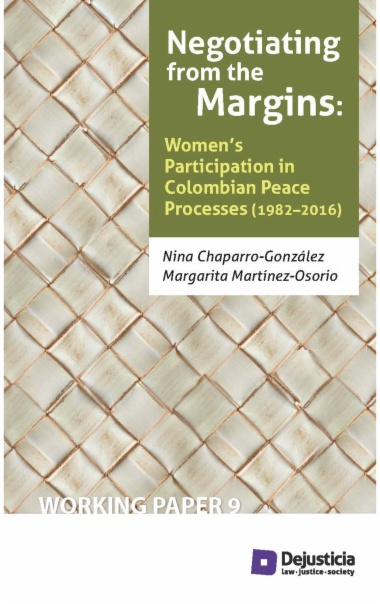In this book, we offer an examination of and recommendations for women’s participation in Colombia’s peace processes, with an eye toward strengthening spaces for participation and, in doing so, ensuring that the peace accord is ultimately translated into long-term social pacts that are inclusive and committed to justice and equity.
- Cover
- Title page
- Copyright page
- Contents
- Ideas for Peace Making
- Introduction
- Conceptual Framework and Methodology
- Women in Peace Processes
(1982–2016): Inclusion, Representation,
and the Institutionalization of Gender in Colombia
- The Betancur Era (1982–1986): The First
Milestone in Women’s Inclusion in Colombian
Peace Processes
- The 1991 National Constituent Assembly:
Tensions, Possibilities, and Advocacy Strategies
around a New Social Pact
- The Samper Era (1994–1998) and Institutional
Frameworks for Gender Equality: Tensions,
Progress, and Dialogue with the Feminist Movement
- Caguán: The Great Milestone
in Women’s Participation
- The Uribe Administration (2002–2010): An End
to Dialogue with Civil Society and the Struggle for
Women’s Representation
- The Peace Process during the Santos
Administration (2010–2016): Expectations,
Concerns, and Challenges
- The Challenges: How Can Women’s Participation
Be Ensured in the Current Peace Process?
- Recommendations: How Can We Guarantee
a Basic Minimum and a Fair Minimum for Women’s
Political Participation?
- Recommendations for the Short Term: Gender-
Focused Education
- Recommendations for the Medium Term: Putting
Transitional Justice “from Below” into Practice
- Recommendations for the Long Term: Gender
Mainstreaming
- References
- Annex 1
- Interviewee Profiles
- Olga Amparo Sánchez Gómez
- Beatriz Helena Quintero García
- Cecilia Barraza Morelle
- Gloria Tobón Olarte
- Claudia Cecilia Ramírez Cardona
- María Emma Wills Obregón
- Annex 2
- Feminist Organizations Mentioned by Interviewees
- Annex 3
- Transitional Justice Agreements
Reached in Havana That Establish Explicit
Gender-Based Commitments

